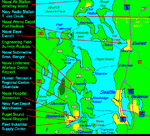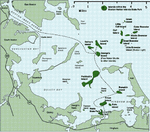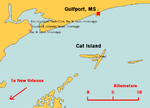Freebird
Master Sergeant
Here is something I was wondering about, what would the effect been on Australian public opinion government policy in WWII if the Japanese had made some actual ground attacks on Australia, (or Canada or the USA), in the form of commando raids?
Suppose for example that the Japanese had set up a few small "tramp" freighters as commando ships. They would transport on the foredeck a few small pleasure or fishing boats. (eg. 50' - 60' long) They would have Dutch captain officers (German operatives) and Indonesian crew (actually Japanese commandos)
At the time there was limited patrol in Australian waters, so by avoiding common shipping routes they could approach coastal areas at night probably undetected. In the unlikely event that they are approached they would have fake papers showing that they are a Dutch Indonesian ship evacuating some boats other cargo from the growing tension in the East. A Japanese submarine could shadow the freighter, and 9posing as a U-boat) attack any HMAS cruiser if it was going to search the freighter. The commando ship would also have a few torpedoes 6" guns hidden for defence. (eg like "Kormoran" had against HMAS Sydney)
When the freighter arrives in Australian waters, late at night on the day before "Pearl Harbour" , in some isolated bay the smaller pleasure craft or fishboats would be lowered into the water. Each would carry 30 or 40 commandos, infantry guns, MG's mortars, plus supplies. The smaller boats with 80 - 150 commandos make a landing on a small sparsely populated island near a major port. For example St. Helena island in Moreton bay near Brisbane, formerly a prison but mainly abandoned after 1935. After the Japanese enter the war by attacking Malaya Hawaii, the commandos create the maximum amount of havoc by sinking a few freighters or HMAS ships, shelling the port, nearby city other infrastructure targets. It would be a suicide mission of course, when attacked the commandos would try to take out as many Allied troops as possible. (eg. like Okinawa or Iwo Jima). When the last commandos are finally wiped out, it would be found that their commander had (how very unfortunate!) failed to destroy papers showing the landing areas for a future Japanese invasion of Queensland, NSW N. Australia etc.
I wonder what the effect on public opinion would be? The objective of course would be to cause panic in the Allied countries, forcing them to put troops to garrison coastlines in Australia elsewhere. The Japanese would not really intend to invade, but would hope that this disinformation would cause Australia to waste extra troops guarding their coastal areas.
I was thinking of the story my grandmother told, of the panic created by a Japanese sub shelling a lighthouse on the Canadian West Coast, when there were rumours that the Japanese were going to invade.
Suppose for example that the Japanese had set up a few small "tramp" freighters as commando ships. They would transport on the foredeck a few small pleasure or fishing boats. (eg. 50' - 60' long) They would have Dutch captain officers (German operatives) and Indonesian crew (actually Japanese commandos)
At the time there was limited patrol in Australian waters, so by avoiding common shipping routes they could approach coastal areas at night probably undetected. In the unlikely event that they are approached they would have fake papers showing that they are a Dutch Indonesian ship evacuating some boats other cargo from the growing tension in the East. A Japanese submarine could shadow the freighter, and 9posing as a U-boat) attack any HMAS cruiser if it was going to search the freighter. The commando ship would also have a few torpedoes 6" guns hidden for defence. (eg like "Kormoran" had against HMAS Sydney)
When the freighter arrives in Australian waters, late at night on the day before "Pearl Harbour" , in some isolated bay the smaller pleasure craft or fishboats would be lowered into the water. Each would carry 30 or 40 commandos, infantry guns, MG's mortars, plus supplies. The smaller boats with 80 - 150 commandos make a landing on a small sparsely populated island near a major port. For example St. Helena island in Moreton bay near Brisbane, formerly a prison but mainly abandoned after 1935. After the Japanese enter the war by attacking Malaya Hawaii, the commandos create the maximum amount of havoc by sinking a few freighters or HMAS ships, shelling the port, nearby city other infrastructure targets. It would be a suicide mission of course, when attacked the commandos would try to take out as many Allied troops as possible. (eg. like Okinawa or Iwo Jima). When the last commandos are finally wiped out, it would be found that their commander had (how very unfortunate!) failed to destroy papers showing the landing areas for a future Japanese invasion of Queensland, NSW N. Australia etc.
I wonder what the effect on public opinion would be? The objective of course would be to cause panic in the Allied countries, forcing them to put troops to garrison coastlines in Australia elsewhere. The Japanese would not really intend to invade, but would hope that this disinformation would cause Australia to waste extra troops guarding their coastal areas.
I was thinking of the story my grandmother told, of the panic created by a Japanese sub shelling a lighthouse on the Canadian West Coast, when there were rumours that the Japanese were going to invade.





